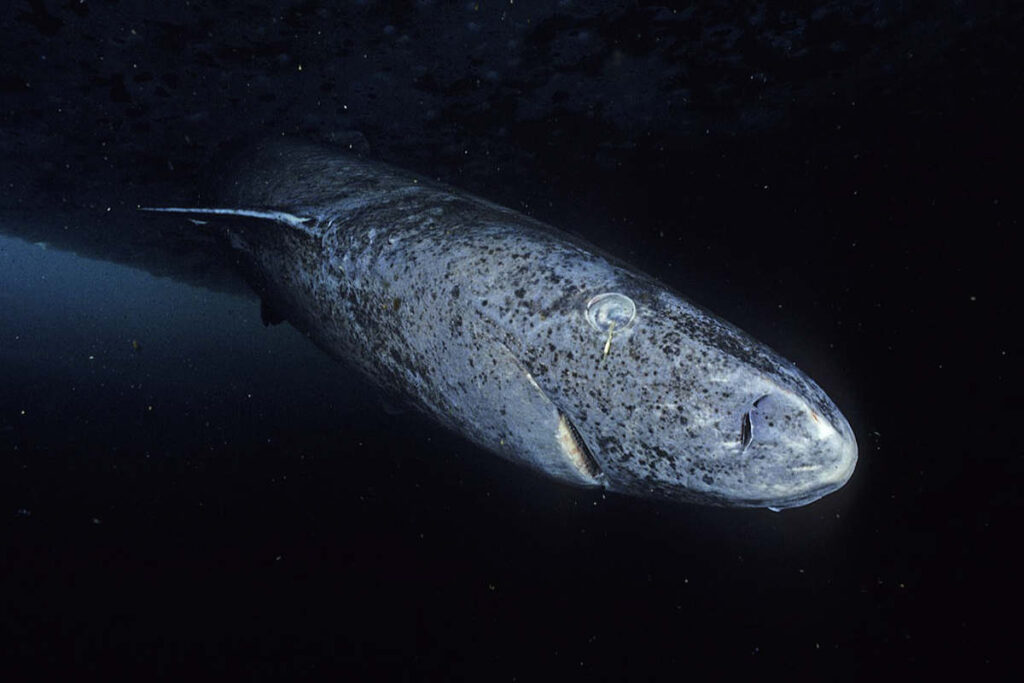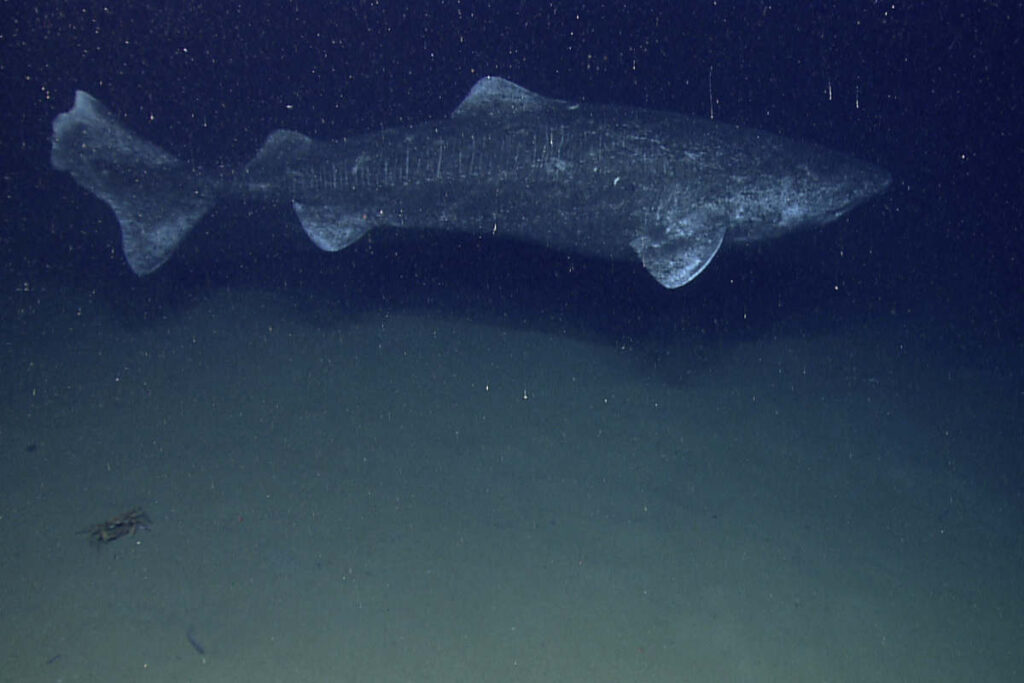Last Reviewed and Updated on March 7, 2023
Greenland sharks, with their unbelievably long life span and impressive size, are one of the most wondrous creatures in the ocean. Let’s delve deep into some of the most interesting facts about Greenland sharks, a species that we are still learning about.

Hemming1952, CC BY-SA 4.0
About Greenland Sharks
Greenland sharks (Somniosus microcephalus) belong to the family Somniosidae (“sleeper sharks”). They are also known by other common names such as gury shark or grey shark.
These sharks are found in the cold waters of the North Atlantic Ocean and the Arctic Ocean. Recent research also suggests their range might be as far south as the Caribbean.
They are one of the largest species of sharks. They usually grow between 7.9 to 14.1 ft / 2.4 to 4.3 m long and weigh between 1,500–2,200 lb / 700–1,000 kg but can grow almost twice this size. Greenland sharks have a distinctive appearance, with a pale grayish-brown to the blackish-brown body, small gill openings, very small fins, short rounded snout, and small, beady eyes.
These large sharks are apex predators. They mostly feed on fish but have a taste for a variety of other prey, such as squid, and even seals. They are also known to scavenge on carrion.
Greenland sharks are slow-growing and long-lived, with a lifespan estimated to be over 400 years. They reach sexual maturity at around 150 years of age, and females usually give birth to litters over 10 pups.
Greenland sharks are considered a “vulnerable” species by the International Union for Conservation of Nature (IUCN). Commercial fishing is the greatest threat to these sharks.
Interesting Facts About Greenland Sharks
Ready to learn some interesting facts about Greenland sharks? Read on.
Also read: 100 strangest facts about animals
1. Greenland sharks have the longest lifespan of all vertebrates
They have the longest known lifespan of all vertebrates (animals with a backbone) and one of the longest lifespans of all known animals. No other fish, mammal, reptile, or amphibian beats them.
Greenland sharks are assumed to reach maturity and begin reproducing when they are 150 years old. In 2016 it was determined that they can live for at least 392 years but likely more. Greenland shark currently holds the Guinness world record for the longest lifespan for a vertebrate.
The only known invertebrate (without a backbone) animals that can outlive the Greenland shark are a couple of sea sponges, corals, some microorganisms, a mollusk or two, and tube worms. There is also the case of the immortal jellyfish, hydra, and skin beetles larvae that are considered biologically immortal.
2. They are one of the few poisonous shark species
Their flesh is toxic. It contains high concentrations of Trimethylamine oxide (TMAO), an organic compound that prevents water pressure from distorting and killing the animal, but it’s toxic if consumed.
If properly treated, the meat can be safe to consume. It needs to be boiled in several changes of water, dried, or fermented for months. Hákarl, fermented Greenland shark or other sleeper sharks, is a traditional dish in Iceland.
3. They like to hunt prey that is asleep
These sharks are relatively slow, so they often hunt prey that is asleep. They will approach the sleeping prey undetected and suck in the prey into their mouth.
4. Polar bears, moose, and reindeer are on their menu as well
They like to fill their stomachs with fish like smaller sharks, skates, eels, herring… But some unexpected prey was also discovered in their stomachs.
While they are apex predators and do hunt their food, they are also scavengers and love all kinds of carrion. Their keen sense of smell will lead them straight to any dead bear, moose, reindeer, or seal in the water.
Fun fact: juvenile Greenland sharks predominantly eat squid.
5. Many Greenland sharks are almost blind
Greenland sharks are often infested by a small crustacean Ommatokoita elongata which attaches itself to the shark’s eyes (to the corneas). The parasite damages the eyes of the shark, which often leads to almost complete blindness (source).
Luckily the Greenland shark heavily relies on its sense of smell and hearing, so the potential blindness does not have an effect on its ability to hunt or their life expectancy.
6. They give birth to live young
Greenland sharks are ovoviviparous, meaning the eggs aren’t laid but instead develop within the mother’s body. Once developed, the mother shark gives birth to live young. They give birth to at least ten live young, but the number could be much higher (source).
The gestation period is unknown. The speculations range from one year and all the way to 18 years, which would make it one of the longest gestation periods in all animals (currently, the longest confirmed gestation period record holders are the frilled sharks).
7. Greenland sharks have the lowest swim speed of all fish (for their size)
Moving at 0.76 mph / 1.22 km/h, with their fastest cruising speed only at 1.6 mph / 2.6 km/h, they are very slow for their size. They also have the slowest tail-beat frequency.
8. They migrate annually based on depth and temperature
During colder months, Greenland sharks congregate in shallow waters. In summer, they migrate to deeper waters.
A recent study also showed these sharks migrate notable horizontal distances as well (source).
9. Inuit legend says the first Greenland shark was born from a cloth soaked in urine
The flesh of Greenland sharks has a high content of urea, a compound found in urine; the flesh has a urine-like smell. Inuit legend says the first Greenland shark, named Skalugsuak was born from a urine-soaked cloth that was blown into the ocean.
10. There are no confirmed Greenland shark attacks on humans
But this isn’t due to them being unable to attack humans or them just being nice. They are more than capable of attacking and injuring humans and would certainly take their chance. However, their natural habitat isn’t exactly friendly to human swimmers, so getting close to one is unlikely. Encounters with humans are exceptionally rare.
There are anecdotal stories about attacks of Greenland sharks in the past, but nothing that can be verified.

